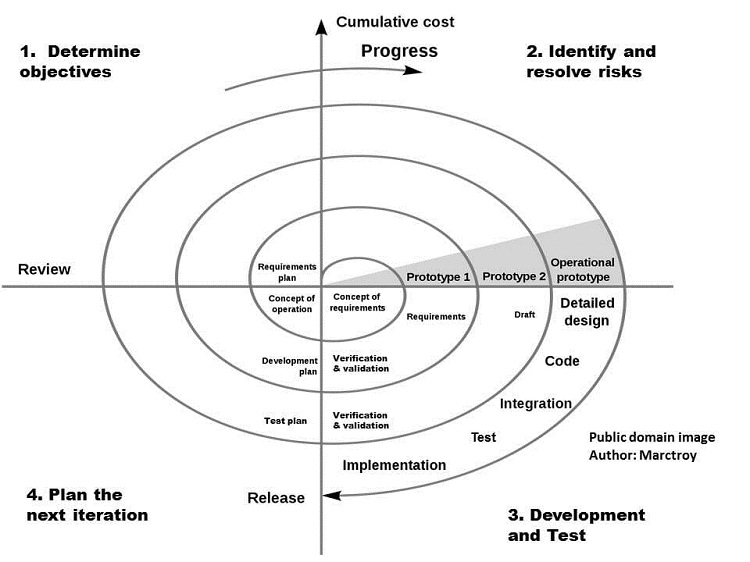In this tutorial you will learn about the Spiral Model and its application with practical example.
Spiral Model
The spiral model, first presented by Boehm, is an evolutionary software process model that combines prototype model’s iterative characteristic with the linear sequential model’s regulated and systematic elements. It implements the possibility for quick creation of new software versions. The programmer is developed in a series of incremental releases using the spiral methodology. The supplementary release may be a paper model or prototype during the early rounds. Later cycles result in increasingly full versions of the designed system.
At each spiral, the Construct phase relates to the making of the original software product. In the baseline spiral, a POC (Proof of Concept) is constructed to get user feedback while the idea is still being considered and the design is being developed. Then, in successive spirals with greater clarity on requirements and design details, a functioning model of the programmer known as a build is created and assigned a version number.
The spiral lifecycle model has the advantage of allowing product elements to be put in as they become available or known. This ensures that no prior needs or designs are in conflict.
Phases of the Spiral model
Each spiral cycle is broken into four different steps:
- Setting objectives: Each cycle in the spiral begins with the identification of the cycle’s goal, the numerous choices for accomplishing the aims, and the restrictions that exist.
- Risk assessment and reduction: The cycle’s next step is to compute these numerous options depending on the goals and restrictions. The focus of evaluation at this stage is on the project’s risk perception.
- Development and validation: The following stage is to create methods to address uncertainties and hazards. Benchmarking, simulation, and prototyping are examples of activities that may be included in this process.
- Finally, the following move has been planned. The project is assessed, and the decision is taken whether to continue with the spiral for another term. If it is chosen to keep, plans for the following stage of the project are developed.

The development stage is determined by the remaining hazards. For example, if performance or user-interface issues are prioritized , than the programmer development risks, the next stage may be an evolutionary development that includes creating a more thorough prototype to address the risks.
The spiral model’s risk-driven aspect allows it to handle any combination of a specification-oriented, prototype-oriented, simulation-oriented, or other type of approach. A critical component of the concept is that each phase of the spiral is followed by a review of all the goods generated during that cycle, as well as planning for the following cycle. The spiral model may be used for both development and upgrade projects.
When to use Spiral Model?
- When delivery is necessary on a regular basis.
- When the project is enormous and the needs are ambiguous and difficult
- Changes may be required at any moment.
- Projects with a large budget
Advantages Of Spiral Model
- A significant degree of risk analysis is required.
- This is useful for large, mission-critical initiatives.
Disadvantages Spiral Model
- It might be an expensive model to utilize.
- Risk analysis need extremely specialized knowledge.
- It is ineffective for smaller tasks.

